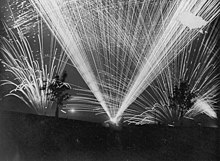Coast Commander East Friesland
Coast Commander Ostfriesland was the name of a military service of the German Navy and its commander. He was responsible for the coastal defense in the Ostfriesland area during the first half of the Second World War . He was subordinate to the chief of the North Sea Naval Station . The headquarters were in Wilhelmshaven .
history
The agency was established under the name fortress commander Ostfriesland in the course of the development of the navy from 1935. After the occupation of the Netherlands in May 1940, the area of responsibility of the coastal commander in Ostfriesland was expanded to include the five northern Dutch coastal provinces. With the beginning of the war she received the designation Coast Commander East Friesland . In February 1941 she was merged with the North Friesland Coast Commander in Chief to become the German Bight Coast Commander .
Commander
The following officers held the post of Coast Commander East Friesland:
- October 1937 - January 1940 Rear Admiral Paul Fanger (initially as fortress commander East Friesland)
- January 1940 - July 1940 Rear Admiral Friedrich-Wilhelm Fleischer
- August 1940 - February 1941 Rear Admiral Johannes Bachmann (subsequently Coast Commander German Bight)
Subordinate associations
The command area of the East Friesland coast commander was divided into seven sections, which in turn were subordinate to smaller units. Several other departments were also directly subordinate to him.
Directly subordinate departments
- II. Naval Artillery Department (Wilhelmshaven)
- VI. Marine artillery department ( Emden )
- Naval flight reporting department Ostfriesland (Wilhelmshaven)
- Marine Motor Vehicle Department Wilhelmshaven
- 2nd Marine Motor Training Department ( North )
- Marine Landesschützenabteilung (Wilhelmshaven)
Section Borkum
Responsible for the island of Borkum and from May 1940 for the Dutch island of Rottum .
- Borkum harbor protection flotilla
- Naval Artillery Division 116
- Naval Flak Division 216
Section Emden
The western part of the East Frisian peninsula without the offshore islands belonged to the Emden section . With the occupation of the Netherlands in May 1940, the Emden section was expanded to include the Dutch provinces of Friesland , Gelderland , Groningen , Overijssel and Utrecht, including the islands of Schiermonnikoog , Ameland , Terschelling and Vlieland .
- Port Commander Delfzijl (from May 1940)
- Port Commander Groningen (from May 1940)
- Port Commander Harlingen (from May 1940)
- Marine Flaka Department 246 (Harlingen) (from May 1940)
- 6. Replacement naval artillery department (Emden)
- 10. Spare Naval Artillery Division (North)
Section Norderney
The Norderney section included the islands of Norderney , Baltrum and Juist .
- Naval Artillery Department 126 (Norderney), disbanded in 1940
- Marine Flaka Department 126 (Norderney)
Section Wangerooge
The Wangerooge section included the islands of Wangerooge , Spiekeroog , and Langeoog . Until January 1940, the section also included the battery in Horumersiel . All other troops were on Wangerooge.
- Naval Artillery Department 112 (until July 1940)
- Naval Artillery Division 132
- Navy Flak Division 232
Wilhelmshaven section
The eastern part of the East Frisian peninsula without the offshore islands belonged to the Wilhelmshaven section.
- Port protection flotilla Wilhelmshaven
- Wehrmacht commander Wilhelmshaven
- 2nd Marine Flak Regiment (Wilhelmshaven)
- Marineflakabteilung 212 (Wilhelm Haven, Fortifikationsstraße) with Flakbatterie Kirchreihe , Flakbatterie Geniusbank , Flakbatterie Rüstersiel and Flakbatterie Schaar
- Marine flak department 222 ( Vareler Hafen) with Flak battery Seefeld , Flak battery Schweiburg , Flak battery Dangast , Flak battery Vareler Hafen , Flak battery Blauhand and the floating flak battery Medusa
- Marine flak department 252 ( Heidmühle ) with flak battery Hohemey , flak battery Schortens , flak battery Siebetshaus and flak battery Sillenstede
- Marine flak department 262 (Wilhelmshaven, Schleusen / Westwerft), flak batteries Sande , flak batteries Tirpitzhafen and flak batteries Tirpitzschleuse
- Marine flak department 272 ( Tossens ) with flak battery Kilwa , flak battery Eckwarderhörne and flak battery Langwarden
- Marine Flak Department 282 ( Hooksiel ) with Flak Battery Schillig , Battery Horumersiel , Flak Battery Hooksiel , Flak Battery Sillenstede , Flak Battery Mellum and the floating Flak Battery Arcona
- 2. Replacement naval artillery department (Wilhelmshaven)
Wesermünde section
The coastal area east of the Weser belonged to the Wesermünde section.
- Marine flak department 244 ( Wesermünde ) including the Tabar flak battery .
Section Heligoland
The Helgoland section included the island of Helgoland including the neighboring dune .
- Naval Artillery Division 12
- Naval Flak Division 242
literature
- Walter Lohmann , Hans H. Hildebrand: The German Navy 1939-1945 . Compilation in three volumes. OO 1956. Volume I, main chapter IX, chapter 3


